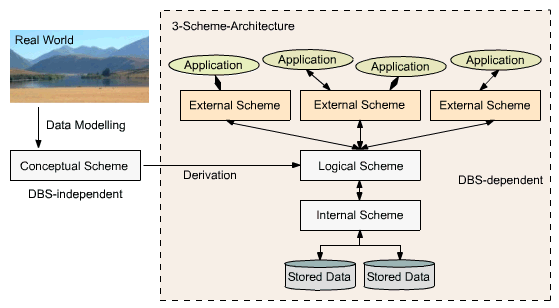|
|
Three-Schemes Architecture
Knowing about the conceptual and the derived logical scheme (discussed in unit Database Models, Schemes and Instances this unit explains two additional schemes - the external scheme and the internal scheme - which help to understand the DBMS architecture.
- External Scheme:
- An external data scheme describes the information about the user view of specific users (single users and user groups) and the specific methods and constraints connected with this information. (Translated) (ZEHNDER 1998)
- Internal Scheme:
- The internal data scheme describes the content of the data and the required service functionality which is used for the operation
of the DBMS. (Translated) (ZEHNDER 1998)
Therefore, the internal scheme describes the data from a view very close to the computer or system in general. It completes the logical scheme with data technical aspects like storage methods or help functions for more efficiency.
 Three-Schemes Architecture
Three-Schemes ArchitectureThe right hand side of the representation above is also called the three-schemes architecture: internal, logical and external scheme.
While the internal scheme describes the physical grouping of
the data and the use of the storage space, the logical scheme (derived from the
conceptual scheme) describes the basic construction of the data structure. The
external scheme of a specific application, generally, only highlights that part
of the logical scheme which is relevant for its application. Therefore, a
database has exactly one internal and one logical scheme but may have several
external schemes for several applications using this database.
The aim of the three-schemes architecture is the separation of the user applications from the physical database, the stored
data. Physically the data is only existent on the internal level while other forms of representation are calculated or derived
respectively if needed. The DBMS has the task to realise this representation between each of these levels.
